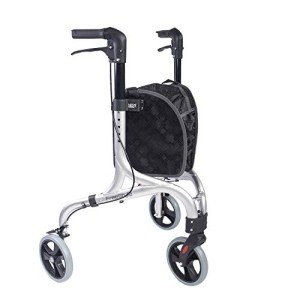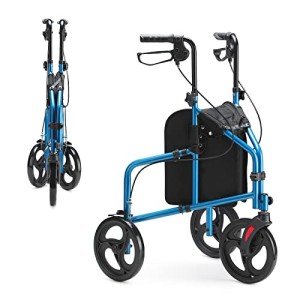
Stylish Rollator
Add a review FollowOverview
-
Founded Date September 3, 1999
-
Sectors Accounting / Finance
-
Posted Jobs 0
-
Viewed 33
Company Description
5 Killer Quora Answers To Indoor Walker
The Rise of Indoor Walkers: A Comprehensive Guide
Indoor walkers have actually emerged as a popular option for individuals looking for to maintain an active lifestyle within the confines of their homes. These flexible devices accommodate a diverse audience, from fitness lovers to those recovering from injuries. This post will explore the basics of indoor walkers, their benefits, types, and some considerations to remember before buying one.
What is an Indoor Walker?
An indoor walker is a physical fitness maker designed to replicate walking without the requirement for outdoor area. Unlike conventional treadmills, which mostly concentrate on running and running, indoor walkers highlight a natural walking movement. They are geared up with functions that promote stability, support, and convenience, making them ideal for a large range of users.

Why Choose an Indoor Walker?
Indoor walkers featured a myriad of benefits that attract users of all ages and fitness levels. A few of the main advantages include:
- Convenience: They can be utilized anytime, despite climate condition or time, making it easier to fit workout into a busy schedule.
- Low Impact: Indoor walkers are created to lower stress on joints, making them an exceptional alternative for those with mobility concerns or joint issues.
- Space-Efficient: Many models are compact and easy to shop, fitting into small apartments or homes with restricted area.
- Variety of Workouts: With adjustable speeds and strength levels, users can customize their workouts to their physical fitness goals.
Kinds Of Indoor Walkers
Indoor walkers come in different styles, each dealing with different user needs. Here are some of the most common types:
| Type | Description | Perfect For |
|---|---|---|
| Handbook Walkers | Operated by the user, moving the limbs in a walking motion. | Novices seeking a basic, cost-effective choice. |
| Motorized Walkers | Geared up with a motor to control speed and incline settings. | Those wanting a more flexible exercise experience. |
| Under-desk Walkers | Compact makers that fit under desks, promoting walking while working. | People working from home looking to stay active. |
| Recumbent Walkers | Enable users to walk in a seated position, minimizing stress on the body. | Older grownups or those with mobility challenges. |
Key Features to Consider
When selecting the right indoor walker, numerous features can affect the overall exercise experience. Here are some essential factors to consider:
- Size and Portability: Ensure it fits your designated exercise area and is quickly movable if required.
- Weight Capacity: Check the optimum weight limitation to make sure safety during workouts.
- Adjustable Settings: Look for machines that offer adjustable speed and incline settings to personalize your exercises.
- User-Friendly Display: Choose an indoor walker with an easy-to-read display that tracks time, range, calories burned, and speed.
- Convenience Features: Consider cushioned manages, adjustable height, and a sturdy base for improved stability and convenience.
Health Benefits of Indoor Walking
Taking part in regular indoor walking can yield various health benefits:
- Enhanced Cardiovascular Health: Walking increases heart rate and improves blood circulation, minimizing the risk of heart illness.
- Weight Management: Regular walking, integrated with a balanced diet plan, aids in weight control and can add to weight-loss.
- Improved Mood: Physical activity releases endorphins, which can help reduce feelings of anxiety and anxiety.
- Enhanced Muscles: Indoor walking strengthens the leg muscles and improves total body coordination and balance.
Setting Up a Walking Routine
To optimize the benefits of indoor walking, it’s necessary to develop a constant regimen. Here are some suggestions to begin:

- Create a Schedule: Dedicate specific times throughout the week for walking. Aim for a minimum of 150 minutes of moderate aerobic activity weekly.
- Heat up and Cool Down: Always begin with a 5-minute warm-up to prepare your body and surface with a cool-down to help recovery.
- Listen to Your Body: Pay attention to how you’re feeling. If you experience pain or pain, stop and evaluate your body’s requirements.
Frequently Asked Questions (FAQs)
Q: How much area do I require for an indoor walker?A: Most indoor walkers are compact and require a small footprint. It’s suggested to have at least 6 to 8 square feet readily available for a safe exercise area. Q: Can indoor walkers be used by olderadults?A: Yes, indoor walkers are exceptional for older grownups as they supply low-impact exercise while promoting stability and mobility. Q: Do I require a fitness center membership if I have an indoor walker?A: No, having an indoor walker allows you to take part in cardio exercises at home, negating the requirement for a health club membership for walking workouts. Q: How do I maintain my indoor walker?A: Regularly look for loose screws, tidy the device after use, and follow the producer’s guidelines for particular maintenance schedules. Q: Are indoor walkers ideal for rehabilitation?A: Yes, many indoor walkers are designed to support rehab, particularly for clients recuperating from surgical treatment or injury. Always talk to a health care expert before starting a new exercise regimen. Indoor walkers offer a hassle-free and effective way to incorporate physical activity into life. With their numerous health benefits, easy to use designs, and versatility, they are an excellent financial investment for anyone seeking to improve their
physical fitness levels in the comfort of their home. By comprehending the various types of indoor walkers, crucial features to consider, and the health advantages of walking, individuals can make informed choices that align with their fitness goals. With commitment and the best devices, staying active has actually never ever been simpler.


